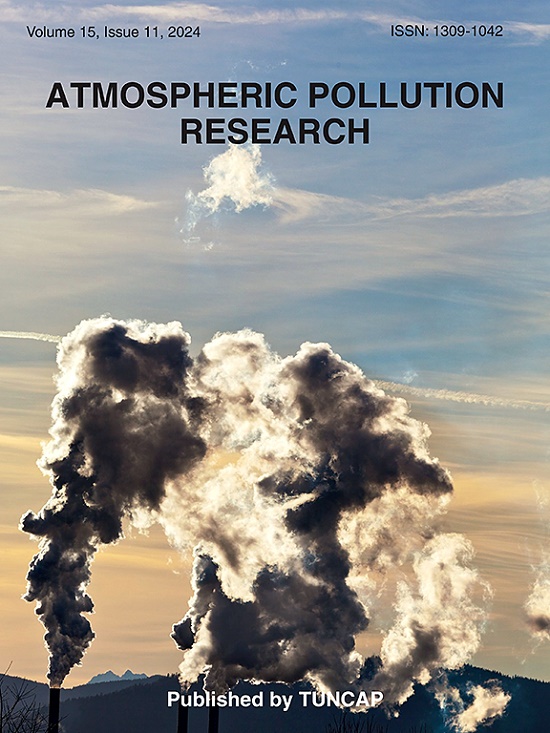Characterization identification and speciated emission inventory construction of anthropogenic volatile organic compounds (VOCs) in Beijing, China
IF 3.9
3区 环境科学与生态学
Q2 ENVIRONMENTAL SCIENCES
引用次数: 0
Abstract
Volatile organic compounds (VOCs) significantly impact air quality and human health, garnering widespread attention. We conducted a comparative analysis of anthropogenic VOC emissions across different years, established a speciated VOC emission inventory for Beijing in 2020 and assessed the ozone formation potential (OFP). The VOC emissions showed a consistent downward trend, ranging from 10.19 × 104 t to 28.36 × 104 t in 2007–2020. The main sectors shifted from mobile sources (43.42%) and solvent utilization (26.35%) in 2007 to solvent utilization (55.99%) and mobile sources (24.00%) in 2020. The key contributing districts shifted from Fangshan (28.92%), Chaoyang (9.84%), and Daxing (7.33%) in 2013 to Chaoyang (14.29%), Haidian (11.42%), and Fangshan (10.33%) in 2020. The profile dataset encompasses 15 sectors and includes 117 VOC species, with an estimated total of 5.07 × 104 t of VOC emissions in 2020, with alkanes, alkenes, alkyne, aromatics, halocarbons, and OVOCs accounting for 34.51%, 17.84%, 1.01%, 36.20%, 7.37%, and 3.07%, respectively. Significant differences were observed in the proportions of various VOC species across sectoral emissions. This dataset shows substantial deviations from the U.S. SPECIATE database, highlighting the significance of developing VOC source profiles. The uncertainties in VOC emission estimates primarily originate from variations in activity levels, emission factors and spatial distribution of emissions. Some sectors with high OFPs, like automobile manufacturing, barbecue and residential combustion are regarded as critical targets for emission control. Aromatics, alkenes, and OVOCs were identified as the major contributors to OFP, and controlling their emissions is essential for reducing ozone formation in Beijing.

北京地区人为挥发性有机化合物(VOCs)特征、鉴定及物种排放清单构建
挥发性有机化合物(VOCs)严重影响空气质量和人体健康,受到广泛关注。通过对不同年份的人为挥发性有机化合物(VOC)排放进行对比分析,建立了北京市2020年VOC排放清单,并评估了臭氧形成潜力(OFP)。2007-2020年,VOC排放量呈持续下降趋势,从10.19 × 104 t下降到28.36 × 104 t。主要行业从2007年的移动来源(43.42%)和溶剂利用(26.35%)转变为2020年的溶剂利用(55.99%)和移动来源(24.00%)。重点贡献区由2013年的房山(28.92%)、朝阳(9.84%)、大兴(7.33%)转变为2020年的朝阳(14.29%)、海淀(11.42%)、房山(10.33%)。该数据集涵盖15个行业,包括117种VOC,预计2020年总VOC排放量为5.07 × 104 t,其中烷烃、烯烃、炔烃、芳烃、卤代烃和VOC分别占34.51%、17.84%、1.01%、36.20%、7.37%和3.07%。不同挥发性有机化合物种类在各行业排放中的比例存在显著差异。该数据集显示了与美国special数据库的重大偏差,突出了开发VOC来源概况的重要性。挥发性有机化合物排放估算的不确定性主要源于活动水平、排放因子和排放空间分布的变化。一些OFPs较高的行业,如汽车制造、烧烤和住宅燃烧,被视为排放控制的关键目标。芳烃、烯烃和挥发性有机化合物是OFP的主要来源,控制它们的排放对减少北京臭氧的形成至关重要。
本文章由计算机程序翻译,如有差异,请以英文原文为准。
求助全文
约1分钟内获得全文
求助全文
来源期刊

Atmospheric Pollution Research
ENVIRONMENTAL SCIENCES-
CiteScore
8.30
自引率
6.70%
发文量
256
审稿时长
36 days
期刊介绍:
Atmospheric Pollution Research (APR) is an international journal designed for the publication of articles on air pollution. Papers should present novel experimental results, theory and modeling of air pollution on local, regional, or global scales. Areas covered are research on inorganic, organic, and persistent organic air pollutants, air quality monitoring, air quality management, atmospheric dispersion and transport, air-surface (soil, water, and vegetation) exchange of pollutants, dry and wet deposition, indoor air quality, exposure assessment, health effects, satellite measurements, natural emissions, atmospheric chemistry, greenhouse gases, and effects on climate change.
 求助内容:
求助内容: 应助结果提醒方式:
应助结果提醒方式:


